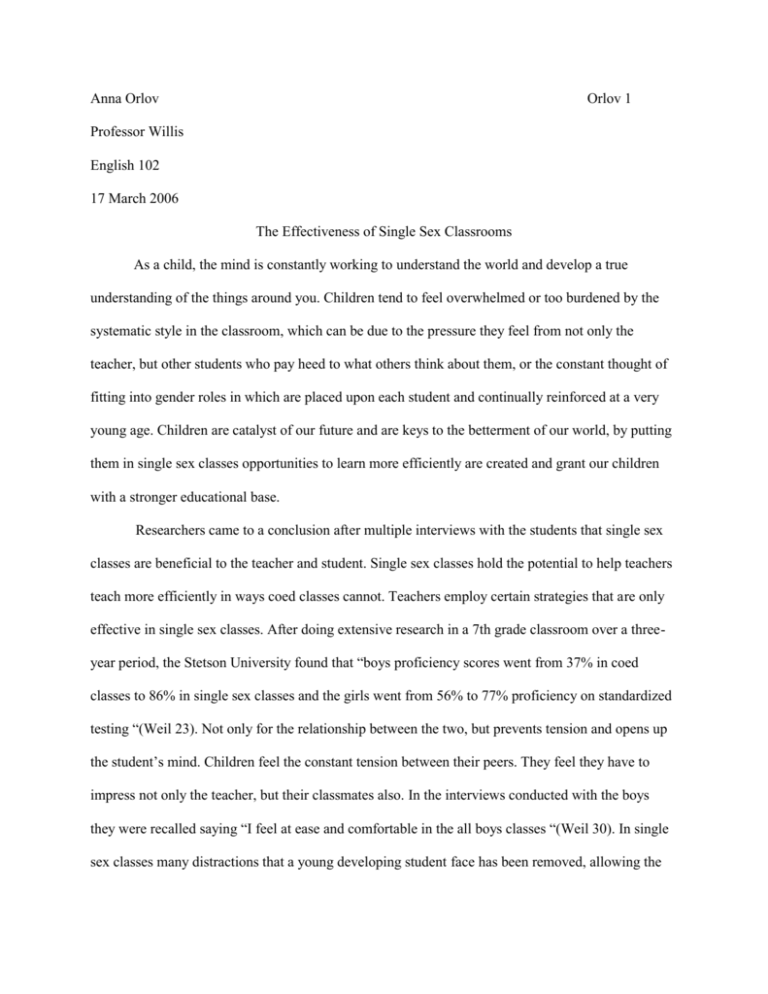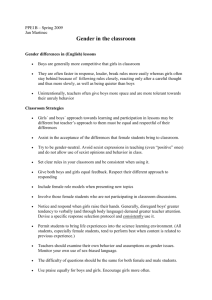MLA example - English 102
advertisement

Anna Orlov Orlov 1 Professor Willis English 102 17 March 2006 The Effectiveness of Single Sex Classrooms As a child, the mind is constantly working to understand the world and develop a true understanding of the things around you. Children tend to feel overwhelmed or too burdened by the systematic style in the classroom, which can be due to the pressure they feel from not only the teacher, but other students who pay heed to what others think about them, or the constant thought of fitting into gender roles in which are placed upon each student and continually reinforced at a very young age. Children are catalyst of our future and are keys to the betterment of our world, by putting them in single sex classes opportunities to learn more efficiently are created and grant our children with a stronger educational base. Researchers came to a conclusion after multiple interviews with the students that single sex classes are beneficial to the teacher and student. Single sex classes hold the potential to help teachers teach more efficiently in ways coed classes cannot. Teachers employ certain strategies that are only effective in single sex classes. After doing extensive research in a 7th grade classroom over a threeyear period, the Stetson University found that “boys proficiency scores went from 37% in coed classes to 86% in single sex classes and the girls went from 56% to 77% proficiency on standardized testing “(Weil 23). Not only for the relationship between the two, but prevents tension and opens up the student’s mind. Children feel the constant tension between their peers. They feel they have to impress not only the teacher, but their classmates also. In the interviews conducted with the boys they were recalled saying “I feel at ease and comfortable in the all boys classes “(Weil 30). In single sex classes many distractions that a young developing student face has been removed, allowing the Orlov 2 student to focus more and pay the teacher more attention which lead to better learning and more time to discuss problems with the material. Males and females have different emotional and cognitive responses, which result in different learning styles being more effective. John Sax, a Swedish researcher found that boys and girls learn differently so their environment can affect performance. There are many intricate differences between boys and girls, but by using a simple example Sax is able to show how single sex classes cater to boys and girls. Through the activity of drawing Sax’s research shows that “girls’ drawings typically depict still lives of people, pets or flowers, using 10 or more crayons, favoring warm colors like red, green, beige and brown; boys, on the other hand, draw action, using 6 or fewer colors, mostly cool hues like gray, blue, silver and black” (Edison 10). This attests to the idea that gender serves as an intricate make up that have some similarities in what attracts either a boy or a girl. Through professional development and the appropriate training teachers will be able to better understand and adjust to the class depending on gender. The certain things which will attract boys our girls will be implemented into each classes criteria in order to obtain the elongated focus of the students for an extended period of time. Works Cited Borst, John. "UP! on Single-Sex Education." Education Today Summer 2004: 7+. Educators Reference Complete. Web. 1 Apr. 2012. Edison, Trickett, Penelope Tricket, Julie Castro, and Paul Schaffner. “The Independent School Experience: Aspects of the Normative Environment of Single-Sex and Co-ed Secondary Schools.” Journal of Educational Psychology, 74.3 (1982): 374-381. Expanded Academic Index Web 1 Apr. 2012. Leo, John. "Boys on the Side." U.S. News & World Report 5 Aug. 1996: 18. Educators Reference Complete. Web. 1 Apr. 2012. Weil, Elizabeth. “Teaching Girls and Boys Separately.” The New York Times. The New York Times, 2 March, 2008. Web. 1 Apr. 2012.











